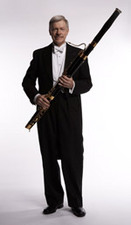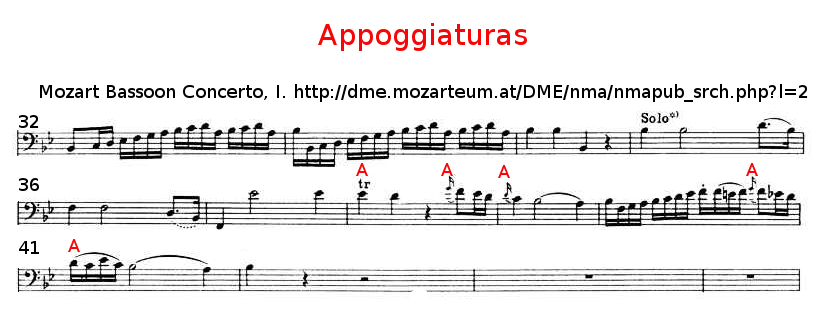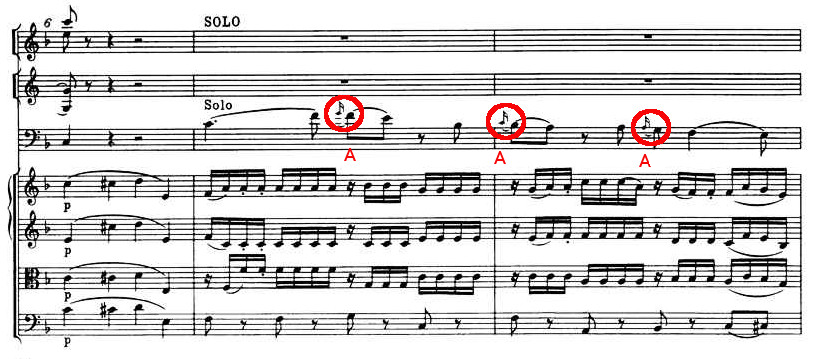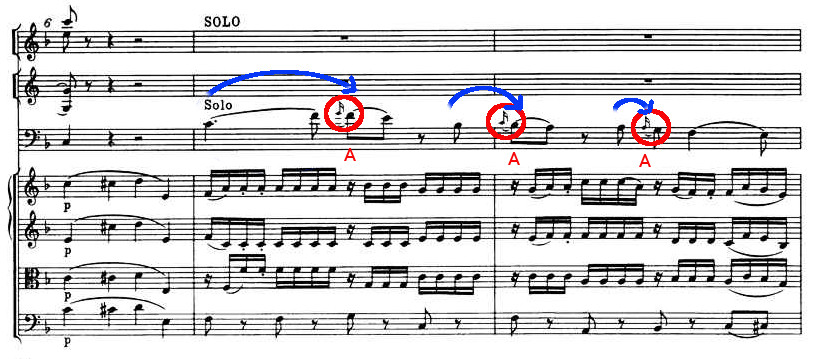1. I have several recordings of the Mozart Bassoon Concerto in my vinyl collection. In addition, I also own several CDs of the Concerto. Despite the time and cost of creating all of these recordings, it appears that we still don’t have a recording of the work with all of Mozart’s notes and with style, ornamentation, and free embellishment appropriate to the Classical period. In this video we will discuss aspects of ornamentation and free embellishment. I hope that it will open your understanding on the topic. Perhaps you will be the person in the future to present the Mozart Bassoon Concerto in its full glory.
2. Part of your education should include a study of ornamentation. This is especially needed since composers from the Baroque period produced volumes of works for the bassoon. Performers who present Baroque compositions without ornamentation are equivalent to Jazz musicians who perform Jazz without improvisation. Neither is historically correct.
3. You might find helpful my video series on ornamentation
YouTube playlist: https://www.youtube.com/watch?v=HfDkjS8VWFQ&list=PL_xCoWcKyxRShO-ClM9O-30dNQ0IAVobo
2reed.net link with videos, music, and articles:
http://www.2reed.net/bdp/home.html#ornamentation
4. Concert reviews and publications in the early 1700s into Schubert’s time in the 1820s and beyond indicate that vocalists regularly added free embellishments to the music, not singing exactly what was on the page. There is thus an unbroken tradition of free embellishment from the Baroque period through Mozart and to later composers in the early Romantic period.
5. Quotation in the video: In the nineteenth century, singers varied their performances much more broadly than twenty-first century vocal practices suggest. Vogl had his own personal style of performance, but it was related to nineteenth-century vocal practices. Vogl's manner coincided with instructions for realizing ornaments and introducing free embellishments found in nineteenth-century vocal treatises. In many cases, there was not a single correct way to realize embellishments in the nineteenth century; instead, there was a range of possibilities.
Joseph R. Matson. Dissertation. “Johann Michael Vogl's alterations to Schubert's "Die schöne Müllerin." University of Iowa, Spring 2009.
6. Thus, an informed performance of the Mozart Bassoon Concerto must include ornamentation beyond that already written in the music. Here are some important publications from that time period to consider:
7. Quantz, Johann Joachim. Versuch einer Anweisung die Flöte traversiere zu spielen .
zu_spielen_(Quantz%2C_Johann_Joachim)
On playing the flute; a complete translation [from the German] with an introd. and notes by Edward R. Reilly. London Faber and Faber (1966).
Bach, Carl Phillip Emanuel. Versuch über die wahre Art das Clavier zu spielen.
http://imslp.org/wiki/Versuch_%C3%BCber_die_wahre_Art_das_Clavier_zu_
spielen,_H.868,_870_(Bach,_Carl_Philipp_Emanuel)
Translation by William J. Mitchell. Essay on the True Art of Playing Keyboard Instruments, New Edition. Ernst Eulenburg Ltd, 1974.
8. Also, of interest are these articles by Robert Levin:
Robert D. Levin. “Improvised Embellishments in Mozart’s Keyboard Music.” Early Music 20/2. Performing Mozart’s Music III (May, 1992), pp. 221-233.
Robert D. Levin. “Performance Prerogatives in Schubert.” Early Music, 25/4 (1 November 1997), pp.723–727.
 9. We should give special thanks to John Miller and his bassoon symposium for supplying us with an article by eminent scholar Frederick Neumann on works for bassoon. If you don’t have time to read the texts I just recommended, you need to read the transcription by David Ross on a lecture given by Dr. Neumann.
9. We should give special thanks to John Miller and his bassoon symposium for supplying us with an article by eminent scholar Frederick Neumann on works for bassoon. If you don’t have time to read the texts I just recommended, you need to read the transcription by David Ross on a lecture given by Dr. Neumann.
Ross, David J. “Ornamentation in the Bassoon Music of Vivaldi and Mozart,” Part II. The Double Reed 9/3 (Winter 1986).
10. This article provides a quick summary of ornamentation in Mozart’s music for bassoon. An online version of the text is available on archive.org.
https://web.archive.org/web/20150312042218/http://www.idrs.org:80/
publications/controlled/DR/DR9.3/DR9.3.Ross.html
11. The figures, however, are missing in this free version so you need to gain access to the article either through joining the International Double Reed Society or finding a copy of the journal.
12. Neumann in his lecture makes an important observation that Italy rather than northern Germany provides influence for ornamentation in Mozart’s work. Mozart’s father made three extended trips to Italy with the young Wolfgang between 1769 and 1773. Wolfgang’s love of opera also is further evidence of the influence of Italian composers. It is not surprising then, that W. A. Mozart’s music is characterized by vocal qualities, including choices of ornamentation.
13. The Neumann article includes many examples of ornaments in the Concerto. Time doesn’t allow for me to discuss them all, so I will just present one example in this video and one in the next. Please note that Neumann gives these as recommendations, not rules.
14. The most important ornament in Baroque, Classical, and even Romantic music is the appoggiatura. This ornament creates one of the most powerful expressive gestures in Common Practice music and often is the goal of musical phrasing. If you have time to study just one ornament, this is the one!

15. Quantz thinks so highly of the appoggiatura that it is listed first among all ornaments in his treatise.
16. The word appoggiatura comes from the Italian appoggiare, to lean. Appoggiaturas are metrically stressed dissonances. Often these appear on downbeats. These notes have stress and weight.
17. Let’s examine the opening of the Second movement bassoon solo. In the Urtext edition we find three grace notes, which here are placed in red circles with the main notes.

18. In figure 24, Neuman provides the Urtext edition on the top and his notation on the bottom. Although the notation on the top appears similar, the end result below is quite different.

The first two grace notes are played before the beats. In the last example, however, the grace note is played on the beat. The only way to understand why this is the case is to examine the harmony. Note that the bassoonist needs to be aware of the notes in other instruments not just in the solo bassoon part! Without an understanding of the harmony, there cannot be an appropriate choice.

Here is the Urtext edition with markings for harmony and appoggiaturas. The first grace note is a chord member. G4 is part of a C major chord. Thus, this note is not a dissonance and cannot be an appoggiatura. Appoggiaturas are always dissonances. Because the first grace note is not dissonant, it must be played before the beat. The second grace note is similar to the first, it is also not a dissonance. This grace note must be before the beat. The appoggiatura is on the Bb3 and is already written into the music. The last grace note, however, is a dissonance and should thus be played as an appoggiatura on the beat. It is a stressed note that is played with a 16th note value.

Notice that the appoggiaturas are the goals of gestures in the solo. The notes prior to the appoggiatura’s musically lead to them. Although the last grace note in print appears to be less important than the surrounding notes, it should in fact be emphasized by the performer with significant weight.
In the next video we will examine appoggiaturas with trills.
<Music: Vincent Igusa, bassoon, and Catherine Renggli, piano. Towson University Recital Hall, 20 June 2017.>
